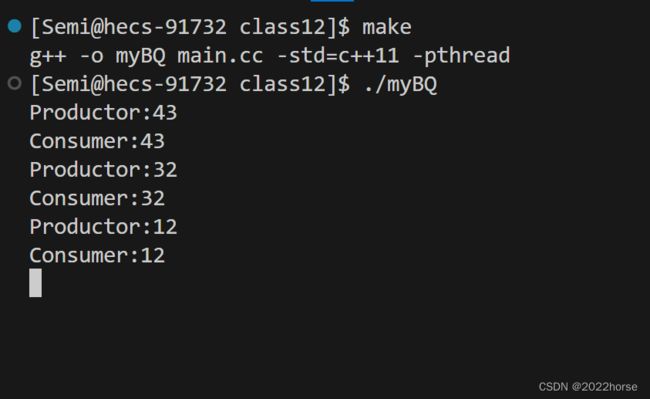【Linux】生产者消费者模型
生产者消费者模型
- 一、生产者消费者模型
-
- 1、生产者消费者模型概念
- 2、生产者消费者模型的特点
-
- (1)生产者和生产者、消费者和消费者、生产者和消费者,它们之间为什么会存在互斥关系?
- (2)生产者和消费者之间为什么会存在同步关系?
- 3、生产者消费者模型优点
- 二、基于BlockingQueue的生产者消费者模型
-
- 1、基于阻塞队列的生产者消费者模型
- 2、模拟实现基于阻塞队列的生产消费模型
-
- (1)消费者和生产者步调一致
- (2)生产者生产的快,消费者消费的慢
- (3)生产者生产的慢,消费者消费的快
- (4)满足某一条件时再唤醒对应的生产者或消费者
- (5)基于计算任务的生产者消费者模型
一、生产者消费者模型
1、生产者消费者模型概念
生产者消费者模式就是通过一个容器来解决生产者和消费者的强耦合问题。
生产者和消费者彼此之间不直接通讯,而通过这个容器来通讯,所以生产者生产完数据之后不用等待消费者处理,直接将生产的数据放到这个容器当中,消费者也不用找生产者要数据,而是直接从这个容器里取数据,这个容器就相当于一个缓冲区,平衡了生产者和消费者的处理能力,这个容器实际上就是用来给生产者和消费者解耦的。
2、生产者消费者模型的特点
生产者消费者模型是多线程同步与互斥的一个经典场景,其特点如下:
- 三种关系: 生产者和生产者(互斥关系)、消费者和消费者(互斥关系)、生产者和消费者(互斥关系、同步关系)。
- 两种角色: 生产者和消费者。(通常由进程或线程承担)
- 一个交易场所: 通常指的是内存中的一段缓冲区。
我们用代码编写生产者消费者模型的时候,本质就是对这三个特点进行维护。
(1)生产者和生产者、消费者和消费者、生产者和消费者,它们之间为什么会存在互斥关系?
生产者和消费者之间的容器可能会被多个执行流同时访问,因此我们需要将该临界资源用互斥锁保护起来。其中,所有的生产者和消费者都会竞争式的申请锁,因此生产者和生产者、消费者和消费者、生产者和消费者之间都存在互斥关系。
(2)生产者和消费者之间为什么会存在同步关系?
- 如果让生产者一直生产,那么当生产者生产的数据将容器塞满后,生产者再生产数据就会生产失败。
- 反之,让消费者一直消费,那么当容器当中的数据被消费完后,消费者再进行消费就会消费失败。
注意: 互斥关系保证的是数据的正确性,而同步关系是为了让多线程之间协同起来。
3、生产者消费者模型优点
- 解耦。
- 支持并发。
- 支持忙闲不均。
如果我们在主函数中调用某一函数,那么我们必须等该函数体执行完后才继续执行主函数的后续代码,因此函数调用本质上是一种紧耦合。
对应到生产者消费者模型中,函数传参实际上就是生产者生产的过程,而执行函数体实际上就是消费者消费的过程,但生产者只负责生产数据,消费者只负责消费数据,在消费者消费期间生产者可以同时进行生产,因此生产者消费者模型本质是一种松耦合。
二、基于BlockingQueue的生产者消费者模型
1、基于阻塞队列的生产者消费者模型
在多线程编程中,**阻塞队列(Blocking Queue)**是一种常用于实现生产者和消费者模型的数据结构。
其与普通的队列的区别在于:
- 当队列为空时,从队列获取元素的操作将会被阻塞,直到队列中放入了元素。
- 当队列满时,往队列里存放元素的操作会被阻塞,直到有元素从队列中取出。
2、模拟实现基于阻塞队列的生产消费模型
为了方便理解,下面我们以单生产者、单消费者为例进行实现。

代码演示:
BlocQueue.hpp:
#include 说明:
- 由于我们实现的是单生产者、单消费者的生产者消费者模型,因此我们不需要维护生产者和生产者之间的关系,也不需要维护消费者和消费者之间的关系,我们只需要维护生产者和消费者之间的同步与互斥关系即可。
- 将BlockingQueue当中存储的数据模板化,方便以后需要时进行复用。
- 这里设置BlockingQueue存储数据的上限为5,当阻塞队列中存储了五组数据时生产者就不能进行生产了,此时生产者就应该被阻塞。
- 阻塞队列是会被生产者和消费者同时访问的临界资源,因此我们需要用一把互斥锁将其保护起来。
- 生产者线程要向阻塞队列当中Push数据,前提是阻塞队列里面有空间,若阻塞队列已经满了,那么此时该生产者线程就需要进行等待,直到阻塞队列中有空间时再将其唤醒。
- 消费者线程要从阻塞队列当中Pop数据,前提是阻塞队列里面有数据,若阻塞队列为空,那么此时该消费者线程就需要进行等待,直到阻塞队列中有新的数据时再将其唤醒。
- 因此在这里我们需要用到两个条件变量,一个条件变量用来描述队列为空,另一个条件变量用来描述队列已满。当阻塞队列满了的时候,要进行生产的生产者线程就应该在full条件变量下进行等待;当阻塞队列为空的时候,要进行消费的消费者线程就应该在empty条件变量下进行等待。
- 不论是生产者线程还是消费者线程,它们都是先申请到锁进入临界区后再判断是否满足生产或消费条件的,如果对应条件不满足,那么对应线程就会被挂起。但此时该线程是拿着锁的,为了避免死锁问题,在调用pthread_cond_wait函数时就需要传入当前线程手中的互斥锁,此时当该线程被挂起时就会自动释放手中的互斥锁,而当该线程被唤醒时又会自动获取到该互斥锁。
- 当生产者生产完一个数据后,意味着阻塞队列当中至少有一个数据,而此时可能有消费者线程正在empty条件变量下进行等待,因此当生产者生产完数据后需要唤醒在empty条件变量下等待的消费者线程。
- 同样的,当消费者消费完一个数据后,意味着阻塞队列当中至少有一个空间,而此时可能有生产者线程正在full条件变量下进行等待,因此当消费者消费完数据后需要唤醒在full条件变量下等待的生产者线程。
判断是否满足生产消费条件时不能用if,而应该用while:
- pthread_cond_wait函数是让当前执行流进行等待的函数,是函数就意味着有可能调用失败,调用失败后该执行流就会继续往后执行。
- 其次,在多消费者的情况下,当生产者生产了一个数据后如果使用pthread_cond_broadcast函数唤醒消费者,就会一次性唤醒多个消费者,但待消费的数据只有一个,此时其他消费者就被伪唤醒了。
- 为了避免出现上述情况,我们就要让线程被唤醒后再次进行判断,确认是否真的满足生产消费条件,因此这里必须要用while进行判断。
在主函数中我们就只需要创建一个生产者线程和一个消费者线程,让生产者线程不断生产数据,让消费者线程不断消费数据。
main.cc:
#include"BlockQueue.hpp"
void* Product(void* arc)
{
BlockQueue<int>* bq = (BlockQueue<int>*)arc;
// 生产者进行生产数据
while(1)
{
sleep(1);
int data = rand() % 100 + 1;
bq->Push(data);
std::cout << "Productor:" << data << std::endl;
}
}
void* Consume(void* arc)
{
BlockQueue<int>* bq = (BlockQueue<int>*)arc;
// 消费者进行消费数据
while(1)
{
sleep(1);
int data = 0;
bq->Pop(data);
std::cout << "Consumer:" << data << std::endl;
}
}
int main()
{
srand((unsigned int)time(nullptr));
// 消费者和生产者
pthread_t productor, consumer;
BlockQueue<int>* bq = new BlockQueue<int>;
// 创造
pthread_create(&productor, nullptr, Product, bq);
pthread_create(&consumer, nullptr, Consume, bq);
// 等待
pthread_join(productor, nullptr);
pthread_join(consumer, nullptr);
delete bq; // 防止内存泄露
return 0;
}
说明:
- 阻塞队列要让生产者线程向队列中Push数据,让消费者线程从队列中Pop数据,因此这个阻塞队列必须要让这两个线程同时看到,所以我们在创建生产者线程和消费者线程时,需要将该阻塞队列作为线程执行例程的参数进行传入。
- 代码中生产者生产数据就是将获取到的随机数Push到阻塞队列,而消费者消费数据就是从阻塞队列Pop数据,为了便于观察,我们可以将生产者生产的数据和消费者消费的数据进行打印输出。
(1)消费者和生产者步调一致
我们上述的代码就是消费者和生产者步调一致,生产者生产一个消费者消费一个,我们直接./来进行查看:

注意:以.hpp为后缀的文件也是头文件,该头文件同时包含类的定义与实现,调用者只需include该hpp文件即可。因为开源项目一般不需要进行保护,所以在开源项目中用的比较多。
(2)生产者生产的快,消费者消费的慢
void* Product(void* arc)
{
BlockQueue<int>* bq = (BlockQueue<int>*)arc;
// 生产者进行生产数据
while(1)
{
int data = rand() % 100 + 1;
bq->Push(data);
std::cout << "Productor:" << data << std::endl;
}
}
void* Consume(void* arc)
{
BlockQueue<int>* bq = (BlockQueue<int>*)arc;
// 消费者进行消费数据
while(1)
{
sleep(1);
int data = 0;
bq->Pop(data);
std::cout << "Consumer:" << data << std::endl;
}
}
此时由于生产者生产的很快,运行代码后一瞬间生产者就将阻塞队列打满了,此时生产者想要再进行生产就只能在full条件变量下进行等待,直到消费者消费完一个数据后,生产者才会被唤醒进而继续进行生产,生产者生产完一个数据后又会进行等待,因此后续生产者和消费者的步调又变成一致的了。

(3)生产者生产的慢,消费者消费的快
void* Product(void* arc)
{
BlockQueue<int>* bq = (BlockQueue<int>*)arc;
// 生产者进行生产数据
while(1)
{
sleep(1);
int data = rand() % 100 + 1;
bq->Push(data);
std::cout << "Productor:" << data << std::endl;
}
}
void* Consume(void* arc)
{
BlockQueue<int>* bq = (BlockQueue<int>*)arc;
// 消费者进行消费数据
while(1)
{
int data = 0;
bq->Pop(data);
std::cout << "Consumer:" << data << std::endl;
}
}
虽然消费者消费的很快,但一开始阻塞队列中是没有数据的,因此消费者只能在empty条件变量下进行等待,直到生产者生产完一个数据后,消费者才会被唤醒进而进行消费,消费者消费完这一个数据后又会进行等待,因此生产者和消费者的步调就是一致的。

(4)满足某一条件时再唤醒对应的生产者或消费者
我们也可以当阻塞队列当中存储的数据大于队列容量的三分之一时,再唤醒消费者线程进行消费;当阻塞队列当中存储的数据小于队列容器的三分之一时,再唤醒生产者线程进行生产。
// BlockQueue.hpp
// 生产者调用向阻塞队列中插入数据
void Push(const T& data)
{
// 1、先上个锁
pthread_mutex_lock(&_mutex);
// 2、判是否满
while(IsFull())
{
// 满了则等待
pthread_cond_wait(&_full, &_mutex);
}
// 3、没满则插入
_q.push(data);
// 4、唤醒在empty下的条件变量
if(_q.size() >= _capcatity / 3)
pthread_cond_signal(&_empty);
// 5、解锁
pthread_mutex_unlock(&_mutex);
}
// 消费者调用向阻塞队列中拿取数据
void Pop(T& data)
{
// 1、先上个锁
pthread_mutex_lock(&_mutex);
// 2、判断是否为空
while(IsEmpty())
{
// 空了则等待
pthread_cond_wait(&_empty, &_mutex);
}
// 3、拿取数据
data = _q.front();
_q.pop();
// 4、唤醒在full下的条件变量
if(_q.size() <= _capcatity / 3)
pthread_cond_signal(&_full);
// 5、解锁
pthread_mutex_unlock(&_mutex);
}
我们仍然让生产者生产的快,消费者消费的慢。运行代码后生产者还是一瞬间将阻塞队列打满后进行等待,但此时不是消费者消费一个数据就唤醒生产者线程,而是当阻塞队列当中的数据小于队列容器的一半时,才会唤醒生产者线程进行生产。
// main.cc
void* Product(void* arc)
{
BlockQueue<int>* bq = (BlockQueue<int>*)arc;
// 生产者进行生产数据
while(1)
{
int data = rand() % 100 + 1;
bq->Push(data);
std::cout << "Productor:" << data << std::endl;
}
}
void* Consume(void* arc)
{
BlockQueue<int>* bq = (BlockQueue<int>*)arc;
// 消费者进行消费数据
while(1)
{
sleep(1);
int data = 0;
bq->Pop(data);
std::cout << "Consumer:" << data << std::endl;
}
}
(5)基于计算任务的生产者消费者模型
我们想要实现一个基于计算任务的生产者消费者模型,此时我们只需要定义一个Task类,这个类当中需要包含一个Run成员函数,该函数代表着我们想让消费者如何处理拿到的数据。
BlockQueue.hpp:
#include main.cc:
#include"BlockQueue.hpp"
void* Product(void* arg)
{
BlockQueue<Task>* bq = (BlockQueue<Task>*)arg;
const char* arr = "+-*/%";
//生产者不断进行生产
while (1)
{
//sleep(1);
int x = rand() % 100 + 1;
int y = rand() % 100 + 1;
char op = arr[rand() % 5];
Task t(x, y, op);
bq->Push(t); //生产数据
std::cout << "producer task done" << std::endl;
}
}
void* Consume(void* arg)
{
BlockQueue<Task>* bq = (BlockQueue<Task>*)arg;
//消费者不断进行消费
while (1)
{
sleep(1);
Task t;
bq->Pop(t);
t.Run();
}
}
int main()
{
//srand((unsigned int)time(nullptr));
// 消费者和生产者
pthread_t productor, consumer;
BlockQueue<Task>* bq = new BlockQueue<Task>;
// 创造
pthread_create(&productor, nullptr, Product, bq);
pthread_create(&consumer, nullptr, Consume, bq);
// 等待
pthread_join(productor, nullptr);
pthread_join(consumer, nullptr);
delete bq; // 防止内存泄露
return 0;
}
运行代码,当阻塞队列被生产者打满后消费者被唤醒,此时消费者在消费数据时执行的就是计算任务,当阻塞队列当中的数据被消费到低于一定阈值后又会唤醒生产者进行生产。此后我们想让生产者消费者模型处理某一种任务时,就只需要提供对应的Task类,然后让该Task类提供一个对应的Run成员函数告诉我们应该如何处理这个任务即可。



